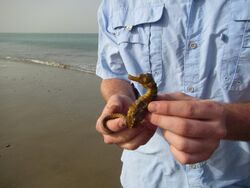Biology:West African seahorse
| West African seahorse | |
|---|---|

| |
| Scientific classification | |
| Domain: | Eukaryota |
| Kingdom: | Animalia |
| Phylum: | Chordata |
| Class: | Actinopterygii |
| Order: | Syngnathiformes |
| Family: | Syngnathidae |
| Genus: | Hippocampus |
| Species: | H. algiricus
|
| Binomial name | |
| Hippocampus algiricus Kaup, 1856
| |
| Synonyms | |
| |
The West African seahorse (Hippocampus algiricus)[3] is a species of fish in the family Syngnathidae (Seahorses and pipefish). It is found in the eastern central Atlantic Ocean off Angola, Benin, Ivory Coast, Gambia, Ghana, Guinea, Liberia, Nigeria, São Tomé and Príncipe, Senegal, and Sierra Leone, as well as the Canary Islands. Although there have been no records from Algeria since Guichenot said that the type was collected at Béjaïa in the 1850s, but the location given may be an error.[1]
There is scarce information despite conservation efforts for this species. The first records of the West African seahorse at Gran Canaria Island, located in the north-east Atlantic Ocean, were confirmed by genetic and morphometric analysis. The West African Seahorse is the only recorded seahorse species in the Canary Islands.[4]
It was first videotaped in 2012. The video is part of a joint investigation between Project Seahorse, Imperial College London, and the Zoological Society of London (ZSL) into West Africa’s burgeoning seahorse trade. The number of seahorses exported, primarily to China for traditional medicine, has risen sharply in the last few years to about 600,000 seahorses annually. Meanwhile, scientists know virtually nothing about their numbers, habitat, or life cycle.[5]
The efforts of Project Seahorse, directed by Dr. Amanda Vincent, resulted in the Convention on Trade in Endangered Species (CITES) adopting international trade controls for seahorses in 2002.[6]
References
- ↑ 1.0 1.1 Pollom, R. (2017). "Hippocampus algiricus". IUCN Red List of Threatened Species 2017: e.T41007A54907846. doi:10.2305/IUCN.UK.2017-3.RLTS.T41007A54907846.en. https://www.iucnredlist.org/species/41007/54907846. Retrieved 14 November 2021.
- ↑ "Appendices | CITES". https://cites.org/eng/app/appendices.php.
- ↑ Scales, Helen (2009). Poseidon's Steed: The Story of Seahorses, From Myth to Reality. Penguin Publishing Group. p. 136. ISBN 978-1-101-13376-7. https://books.google.com/books?id=4Wifibfq2rMC&pg=PT136. Retrieved 9 June 2019.
- ↑ Otero-Ferrer, F.; Herrera, R.; López, A.; Socorro, J.; Molina, L.; Bouza, C. (2015-09-13). "First records of Hippocampus algiricus in the Canary Islands (north-east Atlantic Ocean) with an observation of hybridization with Hippocampus hippocampus". Journal of Fish Biology 87 (4): 1080–1089. doi:10.1111/jfb.12760. ISSN 0022-1112. PMID 26365616.
- ↑ Project seahorse: first ever video footage of elusive West African seahorse . Retrieved 2012-11-01.
- ↑ Cisneros-Montemayor, AM; West K; Boiro IS; Vincent ACJ (2015). "An assessment of West African seahorses in fisheries catch and trade". Journal of Fish Biology 88 (2): 751–759. doi:10.1111/jfb.12818. PMID 26676971. http://www.projectseahorse.org/research-publications/2016/1/11/an-assessment-of-west-african-seahorses-in-fisheries-catch-and-trade. Abstract.
Wikidata ☰ Q2470837 entry
 |


